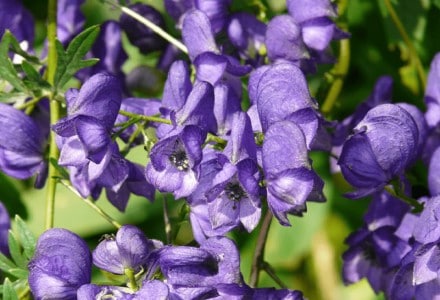
Wolfsbane Facts
- Firstly, the term Wolfsbane serves as one of the common names given to any of the closely related plants within a single genus. Secondly, this genus actually includes many varieties of flora. That’s due to the fact that the group consists of more than 250 different recognized plants.
- Also, almost every known species categorized within that genus has one fascinating, if regrettable, trait in common. That holds true because of the fact that nearly all members of this group rank as extremely poisonous. However, toxicity levels differ between various forms.
- Furthermore, the various plants within the group have historically been of frequent use, because of that toxicity. That’s because, in many remote parts of the world, Indigenous Peoples still make use of Wolfsbane for hunting or warfare. Yet, some types of the plant have medicinal value.
- Quite sadly, the IUCN now lists several members of this remarkable genus as Critically Endangered. Although specific threats vary from species to species, all now face one common threat. That’s because, like many species, Wolfsbane now faces the threat of climate change.
Related Articles
Giant Hogweed Rosy Periwinkle Doll’s Eye
Wolfsbane Physical Description
Since the term Wolfsbane applies to many species, physical variations naturally exist. Firstly, each of them attains different heights at full growth. Secondly, most of them do have certain physical characteristics in common. This includes the fact that all develop as either small to medium-sized plants.
Furthermore, the foliage of most types displays a dark green in color. The leaves also typically develop as palmate in nature. The further usually consist of 5 – 7 segments. The stems also grow tall and erect. Meanwhile, the many flowers may appear as either white, purple, pink, or yellow in color.
In addition, the fruits generally remain small in size. All parts of the different forms of Wolfsbane evolved as highly toxic. Even brushing against it with bare skin remains dangerous. This occurs because the toxin is readily absorbed by the skin. Even a small quantity can be fatal, if ingested.
- Kingdom: Plantae
- Phylum: Angiosperms
- Class: Eudicots
- Order: Ranunculales
- Family: Ranunculaceae
- Genus: Aconitum
Wolfsbane Distribution, Habitat, and Ecology
Quite surprisingly, all recognized varieties of Wolfsbane in this genus developed as native to the Northern Hemisphere. Further, the majority of species evolved as endemic to regions of mountains in North America and Europe. However, many varieties have also been spread to other regions by human actions.
In addition, it possesses quite specific habitat requirements. In fact, it remains most commonly seen in mountainous regions. This genus also most typically grows in soil that stays rather highly retentive of moisture but well drained. Also, all known varieties of this herbaceous genus are perennials.
Despite its toxicity, several types of Wolfsbane serve as a food source for the caterpillar form of several Lepidoptera native to local regions. Finally, with proper preparation, many of the various species also now serve medicinal purposes. This possibility occurs due to the specific compounds found within them.
Species Sharing Its Range
Cougar Flame Azalea Tansy Beetle
Check out our other articles on Earth’s Many Mesmerizing Cephalopods, Blue Footed Booby, Christmas Island, Indian Giant Squirrel, Coral Pink Sand Dune Beetle, Marine Iguana

